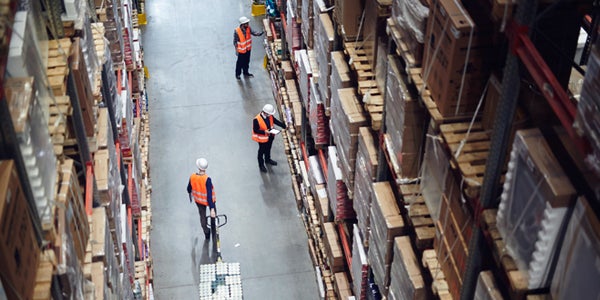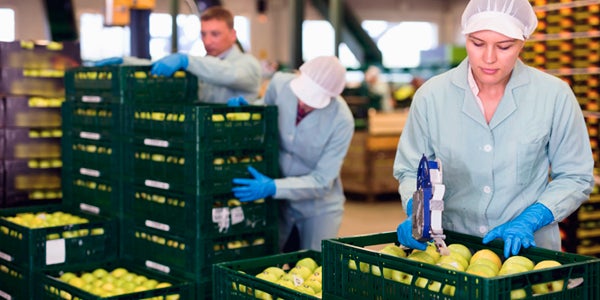There’s never been a more challenging time for food inventory management than the period we’re in now. With an increased focus on health and traceability, customers now want to know your supplier and your supplier’s supplier. As inflation, supply chain issues, and labor shortages continue to drive up the cost of food—especially fresh produce—business leaders must consider every avenue to strengthen their supply chains.
As the country continues to move beyond the tumultuous two-and-a-half-year pandemic, many lingering issues still hinder our return to normalcy. American business leaders of all stripes now face the challenge of orienting toward the future in spite of widespread supply chain bottlenecks and widespread labor shortages—and perhaps none more so than the fresh food and produce industry.

With a nationwide focus on health and wellness, many Americans lean on the importance of food tracing and safety. Fresh food continues to gain popularity in the retail grocery market. This comes with its own difficulties, though—AgriBusiness leaders and grocers alike report difficulties managing their vast inventory amid the surge. Thankfully, robust wholesale inventory management software helps alleviate these pressures.
There’s never been a more challenging time for food inventory management than the period we’re in now. With an increased focus on health and traceability, customers now want to know your supplier and your supplier’s supplier. They also want to know that the food they’re buying comes from safe and sustainable sources.
Needless to say, AgriBusiness retail leaders are already leveraging the capabilities of wholesale inventory management software. However, knowing how to get the most out of these tools is essential for turning profits in the years to come.

Common Challenges in Fresh Produce and Food Food Supply Chain
It’s impossible to pinpoint just one contributing factor when it comes to ongoing issues with the fresh food supply chain. Communication failures can lead to extended delays and shortages, and ineffective warehouse management contributes to costly spoilage—among other mistakes. Heightened public health awareness has amplified the need for accurate traceability and safety measures along the supply chain.
Lapses in Communication
Advancements in communication technologies bind people around the world closer and closer with every passing day. Business leaders on opposite ends of the earth can communicate quickly and accurately, placing orders with precision. Given the sophistication of today’s technology, it’s surprising that lapses in communication still plague the fresh food supply chain today.
How can this be, when every successful company has embraced innovative communication technology? Despite these wholesale adoptions, the culprit is independent logistics.
Every company has its own set of rules and governance. Logistics, information-sharing, and software all fall under that umbrella—not to mention more basic communication barriers like language and geography. For these reasons, despite the newest technology, cogs in the fresh food supply chain still struggle to communicate.
And when companies struggle to communicate, everybody—from the CEO to the customer at the grocery store—suffers. Orders take longer to process, leading to delivery delays and spoilage in the case of time-sensitive food deliveries.

Warehouse Capacity Management
According to an INMAR Intelligence survey, more consumers are making their food purchases online than ever before, leading to a 120% increase in direct-to-customer sales. Food and beverage companies are expanding their product lines to account for this increase in demand. But as demand for products themselves goes up, so does the demand for warehousing space.
This creates even more hurdles for fresh food wholesalers as warehouses reach capacity more rapidly. Moreover, organic foods must remain separate from other goods, leading to further shortages in available warehousing space. Receiving an order for fresh produce without anywhere to put it is perhaps the most frustrating way to lose product.
But wholesalers also don’t want to fall too far under capacity, which can lead to shortages and an inability to fill orders. Wholesale inventory management software can help you keep track of capacity limits and curtail your ordering accordingly to avoid over- or under-filled warehouses. Every link in the supply chain stays happy and profitable with strategic inventory management.
Traceability and Safety
When breakdowns in communication lead to delays and errors, public health and safety risk becomes a genuine concern. According to the CDC, roughly one in six Americans fall ill from contaminated foods and beverages annually—and sadly, 3,000 of those Americans ultimately perish. As manufacturers add new product lines to the supply chain—each with specific storage needs—proper safety communications between wholesalers, suppliers, and end consumers are of the utmost importance.
Maximizing the Benefits of Your Wholesale Inventory Management Software
The challenges facing fresh produce suppliers are many and varied, and getting food to market efficiently in this flux period requires more forethought and precision than perhaps ever before. Thankfully, your inventory management software can help ease any communication snags along the way. A comprehensive, robust warehouse inventory management software—being used to its greatest potential—can help your business ensure that your produce is accounted for and gets where it’s going on time and ahead of spoilage.
Needless to say, managing fresh food inventory isn’t as simple as just keeping tabs on what you have on hand and what you’re running short on. Business leaders must have a deeper understanding of product freshness and the range in which they’ll spoil. They must also manage traceability requirements and other sustainability programs. When effectively utilizing your wholesale inventory management software, you can make these challenges less burdensome for your business.

Keep Your FIFO System Moving
Food and beverage businesses have to maintain rigorous standards set by consumer and regulatory bodies in order to safeguard public health, and experts recommend a strict first-in-first-out (FIFO) system to ensure food safety. Your wholesale inventory management software can provide two-way visibility between suppliers and retailers as products move around facilities and cloud-based systems. This keeps products moving along every link in the supply chain, and ensures that your operations stay regulation-compliant.
Review the capabilities of your inventory management software to ensure you’re taking advantage of all it has to offer. For example, many systems allow for your scan system to be integrated into the platform, allowing ease-of records reporting, quality assurance, and maximum digital visibility. The insight these features offers helps automatically ensure the oldest products go out first—avoiding waste, while new products await delivery in proper quantities and conditions.

Records, Records, Records—For Daily Use and Emergency
To maintain accurate records, you must continually capture and update relevant data at every pivot. When dealing with thousands—if not millions—of units, leveraging automated technologies is crucial. Wholesale inventory management software keeps accurate records of the most minute details that may be relevant in the future.
For instance, in the event of a recall, using all of the serial/batch number recording and documentation management capabilities of your software can effortlessly pinpoint shipments and labels of products in transit or at the market. This allows for more rapid response times, quickly identifying which products contain recalled items and removing them from the supply chain before issues arise.
Keep Your Inventory Balanced
This enhanced supply chain visibility also helps you balance your current inventory levels. Most inventory management software has the capability to accurately forecast future orders months in advance by factoring in the various timetables for fresh food. The software utilizes past sales data, market trends, and seasonality to make these predictions, allowing producers to use the data and order/grow accordingly. Is your purchasing department aware of the capabilities your software has to offer?
Save Space, Save Waste
Warehouses want to make sure every inch of available space gets utilized without going over their capacity. On the other hand, retailers and producers want to ensure they’re not sitting on a surplus of unsellable and soon-to-spoil goods. While some businesses just factor the cost of waste into their annual budget, this sort of thinking just allows waste to proliferate. When effectively utilizing all of the tools your wholesale warehouse inventory management software has to offer, those waste figures can instead bolster the profit margin.
If your software can set maximum stock capabilities and order times for multiple locations and warehouses, consider having a conversation with tech support to ensure all of these features are being used to their full potential, helping to prevent shortage and surplus, leading to higher profits, less waste, and a more expedient ROI.
Automation Can Expedite Your Processes Across the Board
As you’ve hopefully already experienced, investing in automated warehouse management solutions can significantly reduce costs by shaving intangible expenses. Automated inventory management software makes far fewer mistakes than human employees. Thus, if something does go wrong, you don’t have to allocate as many resources toward solving the issue.
Automation also bolsters the value of your labor costs, as workers can focus on more prudent, value-added tasks. For example, wholesale inventory management software can handle menial data entry tasks, significantly boosting productivity by increasing the number of entries and data scans throughout the week. Have you dug into your software’s capabilities so your warehouse staff can spend less time scanning barcodes and inputting data, and more time on high-value tasks?

Spotlight: GrubMarket’s WholesaleWare
Given the abundance of benefits provided by automated inventory management software, it can be helpful to examine real-world applications. Understanding how the software achieves these benefits is crucial in deciding which works best for your company. As a “case study” of sorts, consider how GrubMarket’s WholesaleWare software is doing just that.
According to founder and CEO Mike Xu, WholesaleWare focuses on the food supply chain itself. The software does most of the heavy lifting, tackling inventory management, pricing, and customer relations—three crucial areas in the fresh food industry. Software like WholesaleWare can provide real-time stock updates while also recommending strategic prices to stay ahead of the competition.
Data Entry Error Reduction
As mentioned, wholesale inventory management software cuts back on costly errors that lead to waste and lost profits. It does so by scanning and logging every barcode and SKU that passes through the facility, tracking which orders have arrived and which must go out first. In addition, automated data entry keeps real-time records of your entire inventory stored safely in the cloud.
Inventory Accuracy
While chasing items around the warehouse can pose a challenge, you can locate them easily in a carefully cataloged cloud database. Disorganized warehouses can lead to wasted time searching for particular pallets. With inventory management software, each pallet can be equipped with location tagging technology. WholesaleWare also features a built-in search engine, allowing you to search keywords, product SKUs, or specific names. You can seamlessly track the digital and physical product as it moves both through the warehouse and along the entire fresh food supply chain.
Increased Efficiency
Any inventory management software’s primary goal is to reduce costs while increasing productivity. Automation can handle the mundane, but the better software options will also streamline more nuanced tasks. Software that works from the comfort of your mobile phone allows real-time access to your warehouse inventory 24/7. GrubMarket recognized the need for mobile solutions in the fresh food supply chain, so companies that utilize mobile inventory management apps can communicate with distributors, restaurants, retailers, and customers more efficiently.
Integrate Wholesale Inventory Management Software Today to Trim Costs
GrubMarket’s WholesaleWare and other wholesale inventory management software have been around for some time. These products are nothing new, yet they strangely go underutilized in a highly competitive industry.
As inflation, supply chain issues, and labor shortages continue to drive up the cost of food—especially fresh produce—business leaders must consider every avenue to strengthen their supply chains. It might be time to assess whether or not you are using the full functionality of your wholesale inventory management software.
If you are looking for more insights and ways to find efficiencies for your wholesale business, working with a trusted financial partner like Dubuque Bank & Trust, a division of HTLF Bank, with deep industry experience can help you reach your goals. Reach out today.









